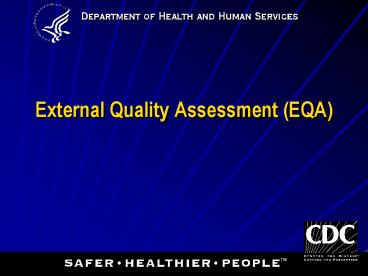External Quality Assessment EQA PowerPoint PPT Presentation
1 / 22
Title: External Quality Assessment EQA
1
External Quality Assessment (EQA)
2
The Quality System
Information Management
3
The Problem
- A newly appointed supervisor of the laboratory
has begun reviewing past EQA performance reports
The reports indicated a trend in poor performance
on interpreting gram stains. - How should the laboratory investigate this
problem? - What are the implications for patient test
results performed and reported during the same
time period? - What corrective actions might be taken?
4
EQA
- Definitions
- Responsibilities
- EQA benefits
- EQA methods
- Documentation
- ZINQAPs experience
5
External Quality Assessment
- A system of objectively checking the
laboratorys results by means of an external
agency
6
EQA Methods
- Proficiency Testing
- Split Sample Comparison
- Blinded Rechecking
- On-site Evaluation
7
Proficiency Testing
- A program in which multiple samples are
periodically sent to members of a group of
laboratories for analysis and/or identification
whereby each laboratorys results are compared
with those of other laboratories in the group
and/or with an assigned value, and reported to
the participating laboratories and others.
(NCCLS)
8
Split Sample Comparison
- Aliquots of specimens distributed to another
laboratory for testing using the same method
9
Blinded Rechecking
- Random statistical sampling of specimens or
slides for rechecking by a reference laboratory - Rechecking is blinded
10
Onsite Evaluation and Review
- Periodic visits to the laboratory to assess
laboratory practices - Why?
- Obtain a realistic picture of laboratory
practices - Provide assistance with problem areas
11
Laboratory Responsibilites
- Should participate in organized interlaboratory
comparisons, e.g., EQA schemes - Participation in EQA should encompass the extent
and complexity of examination procedures used by
the laboratory - ISO Standard prEN ISO/DIS 15189.2
12
Management Responsibilities
- Develop policy
- Assign responsibility
- Monitor the results of external quality
assessments - Participate in the implementation of corrective
actions - ISO Standard prEN ISO/DIS 15189.2
13
EQA Benefits
- Allows comparison of performance and results
- Serves as an early warning-system for problems
- Identifies systematic kit problems
- Provides objective evidence of laboratory quality
- Serves as an indicator of where to direct
improvement efforts - Identifies training needs
14
Proficiency Testing Process
- Central organization sends out challenge
specimens for testing - Laboratories analyze specimens, return results to
central organization - Results evaluated, laboratories sent scores,
performance report - Laboratories take appropriate corrective actions
and document
15
PT Analysis / Reporting Protocols
- Handle in the same manner as patient/client
samples - Follow your testing strategy
- Use same method
- Analysis by the tech who routinely performs
testing - Conduct testing within required timeframe
- Communicate problems to supervisors, PT
organizers - Inter-laboratory discussion of PT specimens or
results are not permitted
16
Blind Rechecking
- Most commonly used for smears, e.g., TB
- Must consider
- Sample size
- Proper specimen handling
- Procedures to ensure blinding
- Procedures to resolve discrepancies
- Details outlined in EQA for AFB Microscopy
17
Split Sample Comparison
- Evaluates imprecision and testing errors
- Must consider
- Procedures for tracking results
- Procedures for maintaining sample integrity
- Procedures for tracking sample data
- Procedures to resolve discrepancies
18
On-Site Evaluation
- Conducted by
- PT organization
- Laboratory leaders, e.g., provincial, district
supervisors - Consider
- Frequency, e.g., monthly, quarterly
- Use of checklists
- Follow-up to visits
- Monitoring corrective actions
- Training
19
On-site Evaluation Results - Uganda
BEFORE
AFTER
Aziz, M. and G. Bretzel, Int J Tuberc Lung Dis
20026(4)340-349
20
Evaluation of EQA ReportsWhere are the problems?
- Pre-analytic
- Specimen compromised during preparation,
transport, or after receipt by improper storage
or handling - Analytic
- Reagents, instruments, methods, calibration, QC -
Analytical error - Calculation
- Competency of Staff
- Post-analytic
- Report format
- Interpretation
- Data
- Clerical/transcription error
21
Investigating Unacceptable EQA Performance
- Clerical error
- Methodological problem
- Technical problem
- Problem with PT materials
- Problem with evaluation of results
- No explanation
22
EQA Documentation
- Establish written procedures for
- Handling of samples
- Analysis of sample
- Recording of results on report forms
- Verification of clerical accuracy
- Use of statistical tools
- Handling corrective actions

